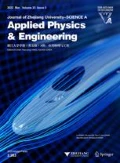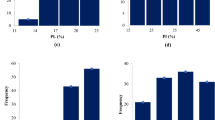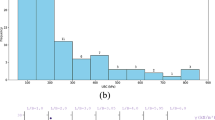Abstract
The compression modulus (Es) is one of the most significant soil parameters that affects the compressive deformation of geotechnical systems, such as foundations. However, it is difficult and sometime costly to obtain this parameter in engineering practice. In this study, we aimed to develop a non-parametric ensemble artificial intelligence (AI) approach to calculate the Es of soft clay in contrast to the traditional regression models proposed in previous studies. A gradient boosted regression tree (GBRT) algorithm was used to discern the non-linear pattern between input variables and the target response, while a genetic algorithm (GA) was adopted for tuning the GBRT model’s hyper-parameters. The model was tested through 10-fold cross validation. A dataset of 221 samples from 65 engineering survey reports from Shanghai infrastructure projects was constructed to evaluate the accuracy of the new model’s predictions. The mean squared error and correlation coefficient of the optimum GBRT model applied to the testing set were 0.13 and 0.91, respectively, indicating that the proposed machine learning (ML) model has great potential to improve the prediction of Es for soft clay. A comparison of the performance of empirical formulas and the proposed ML method for predicting foundation settlement indicated the rationality of the proposed ML model and its applicability to the compressive deformation of geotechnical systems. This model, however, cannot be directly applied to the prediction of Es in other sites due to its site specificity. This problem can be solved by retraining the model using local data. This study provides a useful reference for future multi-parameter prediction of soil behavior.
概要
目的
土体压缩模量是影响岩土体结构变形的重要参数 之一。本文旨在通过机器学习的方法实现对压缩 模量的预测, 并通过构建一个机器学习模型,得 到塑限、液限、塑性指数、液性指数、比贯入阻 力以及埋深这6 个输入参数与压缩模量预测值之 间的关系。
创新点
1. 构建一个机器学习算法框架以实现对土体压缩 模量的预测; 2. 此框架包括梯度提升回归树 (GBRT) 和遗传算法 (GA) 并采用 GA 对GBRT 超参数进行获取。
方法
1. 通过收集整理工程报告获取本次预测的数据集 (样本211 个);输入参数有6 个,分别为塑限、 液限、塑性指数、液性指数、比贯入阻力以及埋 深;输出参数为压缩模量。2. 采用GBRT 算法识 别输入变量与目标响应之间的非线性规律,并采 用GA 调整GBRT 模型的超参数。 3. 模型训练完 成后,对压缩模量进行预测。4. 将测试集上的预 测结果和传统方法进行对比分析并应用到一维 基础沉降中。
结论
1. 本文提出的GA-GBRT 模型可以较好地实现对 土体压缩模量的预测;GA 可以对GBRT 算法的 超参数进行有效标定。2. 训练后的GA-GBRT 模 型在训练集和测试集上都表现良好; 在训练集和 测试集上的相关系数 R 值分别为0.82 和0.91,说 明模型可以对压缩模量进行准确预测。3. 对输入 变量相对重要性的研究发现,液性指标是本研究 中最重要的变量, 其重要性得分为0.313(总数 为1); 其他指标的重要性排序依次为: :液限、塑 限、塑性指数、比贯入阻力和埋深。 4. 对于地基 沉降的预测 本文提出的模型在相关系数 R 值和 Mann-Whitney 检验结果上均优于经验公式。 5. 本 文提出的GA-GBRT 模型可以更经济、更快速地 预测土壤压缩模量。
Similar content being viewed by others
References
Arditi D, Pulket T, 2005. Predicting the outcome of construction litigation using boosted decision trees. Journal of Computing in Civil Engineering, 19(4):387–393. https://doi.org/10.1061/(asce)0887-3801(2005)19:4(387)
Arditi D, Pulket T, 2010. Predicting the outcome of construction litigation using an integrated artificial intelligence model. Journal of Computing in Civil Engineering, 24(1): 73–80. https://doi.org/10.1061/(asce)0887-3801(2010)24:1(73)
Brabie D, Andersson E, 2008. An overview of some highspeed train derailments: means of minimizing consequences based on empirical observations. Proceedings of the Institution of Mechanical Engineers, Part F: Journal of Rail and Rapid Transit, 222(4):441–463. https://doi.org/10.1243/09544097jrrt149
Braga-Neto U, Hashimoto R, Dougherty ER, et al., 2004. Is cross-validation better than resubstitution for ranking genes? Bioinformatics, 20(2):253–258. https://doi.org/10.1093/bioinformatics/btg399
Ching J, Phoon KK, 2014. Correlations among some clay parameters—the multivariate distribution. Canadian Geotechnical Journal, 51(6):686–704. https://doi.org/10.1139/cgj-2013-0353
Clayton CRI, Steinhagen M, Steinhagen HM, et al., 1995. Terzaghi’s theory of consolidation, and the discovery of effective stress (compiled from the work of K. Terzaghi and A.W. Skempton). Proceedings of the Institution of Civil Engineers-Geotechnical Engineering, 113(4):191–205. https://doi.org/10.1680/igeng.1995.28015
Fan HH, Wu PT, Gao JE, et al., 2006. Influence of density and water content on unconfined compression strength of solidified soil. Science of Soil and Water Conservation, 4(3):54–58 (in Chinese). https://doi.org/10.3969/j.issn.1672-3007.2006.03.011
Fenton GA, Griffiths DV, 2008. Risk Assessment in Geotechnical Engineering. Wiley, New York, USA, p.78–101. https://doi.org/10.1002/9780470284704.ch5
Goldberg DE, 1989. Genetic Algorithms in Search, Optimization and Machine Learning. Addison-Wesley Longman Publishing, New York, USA.
Gong Y, Luo XQ, Wang DH, et al., 2018. Urban travel time prediction based on gradient boosting regression tress. Journal of Zhejiang University (Engineering Science), 52(3):453–460 (in Chinese). https://doi.org/10.3785/j.issn.1008-973X.2018.03.006
Huang HW, Zhang DM, 2016. Resilience analysis of shield tunnel lining under extreme surcharge: characterization and field application. Tunnelling and Underground Space Technology, 51:301–312. https://doi.org/10.1016/j.tust.2015.10.044
Huang HW, Gong WP, Khoshnevisan S, et al., 2015. Simplified procedure for finite element analysis of the longitudinal performance of shield tunnels considering spatial soil variability in longitudinal direction. Computers and Geotechnics, 64:132–145. https://doi.org/10.1016/j.compgeo.2014.11.010
Huang HW, Xiao L, Zhang DM, et al., 2017. Influence of spatial variability of soil Young’s modulus on tunnel convergence in soft soils. Engineering Geology, 228:357–370. https://doi.org/10.1016/j.enggeo.2017.09.011
Jalabert SSM, Martin MP, Renaud JP, et al., 2010. Estimating forest soil bulk density using boosted regression modelling. Soil Use and Management, 26(4):516–528. https://doi.org/10.1111/j.1475-2743.2010.00305.x
Johari A, Javadi AA, Habibagahi G, 2011. Modelling the mechanical behaviour of unsaturated soils using a genetic algorithm-based neural network. Computers and Geotechnics, 38(1):2–13. https://doi.org/10.1016/j.compgeo.2010.08.011
Juang CH, Wang L, 2013. Reliability-based robust geotechnical design of spread foundations using multi-objective genetic algorithm. Computers and Geotechnics, 48(4):96–106. https://doi.org/10.1016/j.compgeo.2012.10.003
Khanlari GR, Heidari M, Momeni AA, et al., 2012. Prediction of shear strength parameters of soils using artificial neural networks and multivariate regression methods. Engineering Geology, 137–138:11–18. https://doi.org/10.1016/j.enggeo.2011.12.006
Koo TK, Li MY, 2016. A guideline of selecting and reporting intraclass correlation coefficients for reliability research. Journal of Chiropractic Medicine, 15(2):155–163. https://doi.org/10.1016/j.jcm.2016.02.012
Kulhawy FH, Mayne PW, 1990. Manual on Estimating Soil Properties for Foundation Design. Electric Power Research Institute, Palo Alto, USA.
Lee MJ, Hong SJ, Choi YM, et al., 2010. Evaluation of deformation modulus of cemented sand using CPT and DMT. Engineering Geology, 115(1–2):28–35. https://doi.org/10.1016/j.enggeo.2010.06.016
Lee SJ, Lee SR, Kim YS, 2003. An approach to estimate unsaturated shear strength using artificial neural network and hyperbolic formulation. Computers and Geotechnics, 30(6):489–503. https://doi.org/10.1016/s0266-352x(03)00058-2
Nejad FP, Jaksa MB, Kakhi M, et al., 2009. Prediction of pile settlement using artificial neural networks based on standard penetration test data. Computers and Geotechnics, 36(7):1125–1133. https://doi.org/10.1016/j.compgeo.2009.04.003
Persson C, Bacher P, Shiga T, et al., 2017. Multi-site solar power forecasting using gradient boosted regression trees. Solar Energy, 150:423–436. https://doi.org/10.1016/j.solener.2017.04.066
Qi CC, Tang XL, 2018. Slope stability prediction using integrated metaheuristic and machine learning approaches: a comparative study. Computers & Industrial Engineering, 118:112–122. https://doi.org/10.1016/j.cie.2018.02.028
Qi CC, Fourie A, Ma GW, et al., 2018a. Comparative study of hybrid artificial intelligence approaches for predicting hangingwall stability. Journal of Computing in Civil Engineering, 32(2):04017086. https://doi.org/10.1061/(ASCE)CP.1943-5487.0000737
Qi CC, Fourie A, Chen QS, et al., 2018b. A strength prediction model using artificial intelligence for recycling waste tailings as cemented paste backfill. Journal of Cleaner Production, 183:566–578, https://doi.org/10.1016/j.jclepro.2018.02.154
Rodriguez JD, Perez A, Lozano JA, 2010. Sensitivity analysis of k-fold cross validation in prediction error estimation. IEEE Transactions on Pattern Analysis and Machine Intelligence, 32(3):569–575. https://doi.org/10.1109/TPAMI.2009.187
Roe BP, Yang HJ, Ji Z, et al., 2005. Boosted decision trees as an alternative to artificial neural networks for particle identification. Nuclear Instruments and Methods in Physics Research Section A: Accelerators, Spectrometers, Detectors and Associated Equipment, 543(2–3):577–584. https://doi.org/10.1016/j.nima.2004.12.018
Roy PP, Roy K, 2008. On some aspects of variable selection for partial least squares regression models. QSAR & Combinatorial Science, 27(3):302–313. https://doi.org/10.1002/qsar.200710043
Shahin MA, 2016. State-of-the-art review of some artificial intelligence applications in pile foundations. Geoscience Frontiers, 7(1):33–44. https://doi.org/10.1016/j.gsf.2014.10.002
Shahin MA, Maier HR, Jaksa MB, 2004. Data division for developing neural networks applied to geotechnical engineering. Journal of Computing in Civil Engineering, 18(2):105–114. https://doi.org/10.1061/(asce)0887-3801(2004)18:2(105)
Sridharan A, Nagaraj HB, 2000. Compressibility behaviour of remoulded, fine-grained soils and correlation with index properties. Canadian Geotechnical Journal, 37(3):712–722. https://doi.org/10.1139/t99-128
Tarawneh B, 2017. Predicting standard penetration test N-value from cone penetration test data using artificial neural networks. Geoscience Frontiers, 8(1):199–204. https://doi.org/10.1016/j.gsf.2016.02.003
Tong LY, Tu QZ, Du GY, et al., 2013. Determination of confined compression modulus of soft clay using piezocone penetration tests. Chinese Journal of Geotechnical Engineering, 35(S2):569–572 (in Chinese).
Touzani S, Granderson J, Fernandes S, 2018. Gradient boosting machine for modeling the energy consumption of commercial buildings. Energy and Buildings, 158:1533–1543. https://doi.org/10.1016/j.enbuild.2017.11.039
Tun YW, Pedroso DM, Scheuermann A, et al., 2016. Probabilistic reliability analysis of multiple slopes with genetic algorithms. Computers and Geotechnics, 77:68–76. https://doi.org/10.1016/j.compgeo.2016.04.006
Viswanathan R, Samui P, 2016. Determination of rock depth using artificial intelligence techniques. Geoscience Frontiers, 7(1):61–66. https://doi.org/10.1016/j.gsf.2015.04.002
Yin ZY, Jin YF, Huang HW, et al., 2016. Evolutionary polynomial regression based modelling of clay compressibility using an enhanced hybrid real-coded genetic algorithm. Engineering Geology, 210:158–167. https://doi.org/10.1016/j.enggeo.2016.06.016
Zhang DM, Hu QF, Huang HW, et al., 2018. Nonlinear subgrade reaction solution for circular tunnel lining design based on mobilized strength of undrained clay. Canadian Geotechnical Journal, 55(2):155–170. https://doi.org/10.1139/cgj-2017-0006
Zhou J, Li XB, Mitri HS, 2016. Classification of rockburst in underground projects: comparison of ten supervised learning methods. Journal of Computing in Civil Engineering, 30(5):04016003. https://doi.org/10.1061/(ASCE)CP.1943-5487.0000553
Acknowledgement
The authors thank Li XIAO and Ye-lu ZHOU from Tongji University, China for their help in collecting the original data for this study.
Author information
Authors and Affiliations
Contributions
Dong-ming ZHANG, Jin-zhang ZHANG, Hong-wei HUANG, Chong-chong QI, and Chen-yu CHANG declare that they have no conflict of interest.
Corresponding authors
Additional information
Project supported by the National Natural Science Foundation of China (Nos. 51608380 and 51538009), the Key Innovation Team Program of the Innovation Talents Promotion Plan by Ministry of Science and Technology of China (No. 2016RA4059), and the Specific Consultant Research Project of Shanghai Tunnel Engineering Company Ltd. (No. SLEC/KJB/XMGL/0130), China
Contributors
Hong-wei HUANG and Jin-zhang ZHANG designed the research. Dong-ming ZHANG and Chong-chong QI processed the corresponding data. Jin-zhang ZHANG wrote the first draft of the manuscript. Dong-ming ZHANG and Chong-chong QI helped to organize the manuscript. Hong-wei HUANG and Chen-yu CHANG revised and edited the final version.
Rights and permissions
About this article
Cite this article
Zhang, Dm., Zhang, Jz., Huang, Hw. et al. Machine learning-based prediction of soil compression modulus with application of 1D settlement. J. Zhejiang Univ. Sci. A 21, 430–444 (2020). https://doi.org/10.1631/jzus.A1900515
Received:
Accepted:
Published:
Issue Date:
DOI: https://doi.org/10.1631/jzus.A1900515
Key words
- Compression modulus prediction
- Machine learning (ML)
- Gradient boosted regression tree (GBRT)
- Genetic algorithm (GA)
- Foundation settlement




